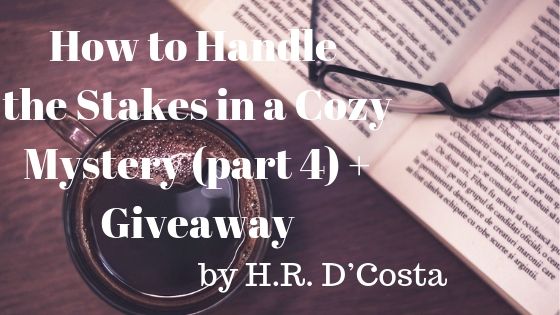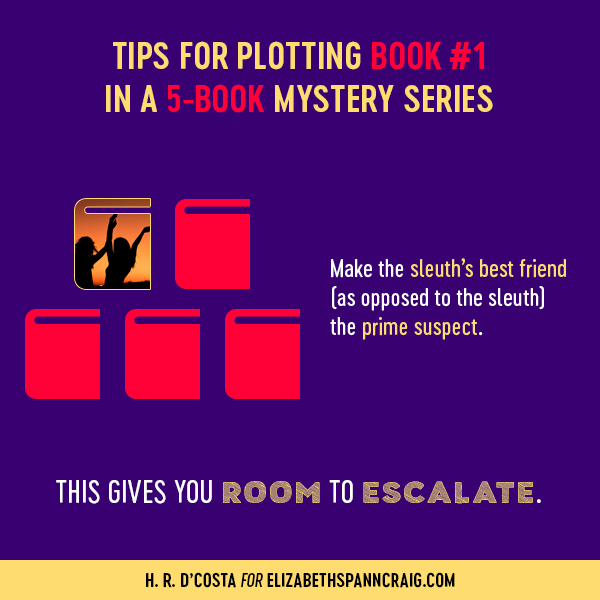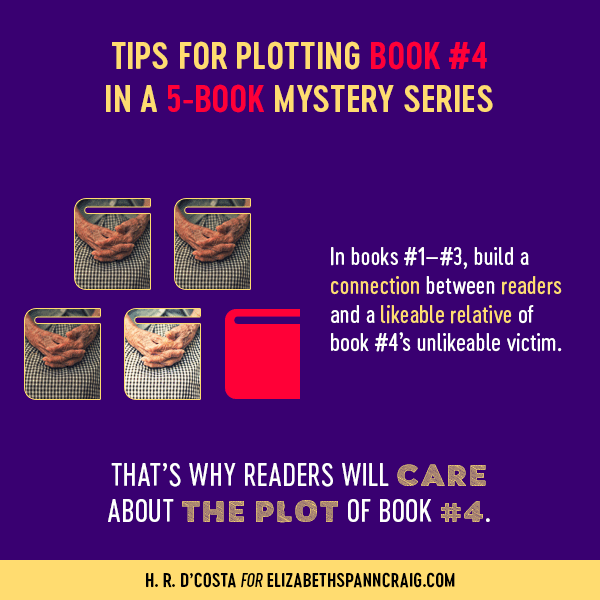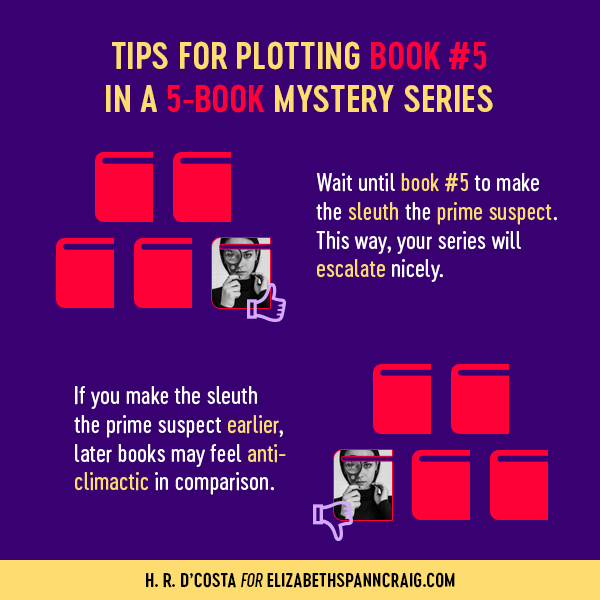
by H.R. D’Costa, @scribesworld
Wow.
We’ve covered a lot of ground in this four-part blog series on how to handle the stakes in a cozy mystery. (By the way, although the illustrative examples are cozy-centric, many of the tips in this series can be applied to mysteries with a harder edge.)
Today, we’re wrapping things up and putting all the tips from Parts 1–3 of the blog series into action. For this post to make the most sense, you should really read the previous ones (if you haven’t already).
If you need to catch up, check out this list of all the posts in this blog series, with convenient links to Parts 1, 2, and 3:
- In Part 1, we covered methods to bolster the stakes that emphasize the sleuth.
- In Part 2, we covered methods to bolster the stakes that emphasize other storytelling elements that readers care about.
- In Part 3, we discussed considerations to take into account when applying these story stake tips to cozy mysteries in a series.
- In Part 4, you’ll see these considerations in action when I share a sample lineup of stakes for a hypothetical cozy-mystery series. (You’re reading Part 4 right now.)
All right. You’re properly oriented. You know that it’s a smart idea to map out the stakes in a cozy-mystery series in advance. That’s because doing so will help you avoid escalation problems in the long run.
When mapping out your stakes, there are three operating principles to keep in mind.
- Ideally, the novels in your series will be more emotionally intense, as your series goes along.
- However, the first book in your series should be engaging enough to lure readers into your series.
- Series loyalty can carry readers through books that might not be as exciting as previous books in a series.
With these principles in hand, you should be able to figure out how to maintain escalation across the books in your cozy-mystery series.
However, before you do this on your own, you might like to see these principles in action.
That’s why I’ve created a sample lineup of stakes to use over the course of a five-book cozy-mystery series. This lineup will give you a sense of the reasoning process you might go through when you map out the stakes in your own series.
Bear in mind, this lineup shouldn’t be treated as a cast-iron mold. It’s there to provide guidance on some considerations that are good to take into account when planning your own cozy-mystery series.
One more thing: unless otherwise indicated, the victim in these plots can be likeable or unlikeable.
In the case of an unlikeable victim, an extra set of stakes (or some other source) supplies the reason for readers to invest in the plot. Using these techniques (as described in Parts 1 and 2 of this blog series) is a must.
In the case of a likeable victim, it’s optional. You don’t need to compensate for the victim’s unlikeability—but, by applying the same techniques, you’ll enhance your readers’ experience.
Okay, here’s the sample lineup:
Story Stakes for Book #1 in a Hypothetical Cozy-Mystery Series
The sleuth’s best friend is the prime suspect, and the sleuth must solve the case to prevent her friend from going to jail.
This situation makes your series entry point an attractive option for readers, who’ll be drawn in by the high-stake situation.
At the same time, the stakes don’t quite reach the same level as when the sleuth herself is the prime suspect—so you’ve left yourself room to escalate.
Story Stakes for Book #2 in a Hypothetical Cozy-Mystery Series
Readers are emotionally invested in the plot because they want to see justice achieved on behalf of the likeable victim who was friends (or friendly) with the sleuth.
To deepen this investment, show your sleuth reminiscing about her interactions with the victim. To take it up a notch, show your sleuth reminiscing about interactions that you actually depicted in book #1.
As your sleuth recalls the details, your readers will remember them too, which’ll make your readers even more connected to the story. (It’s almost like an Easter egg for them.)
This is one example of why it can be advantageous to extensively outline the books in your cozy-mystery series. Doing so also enables you to identify (and fix) plot holes in advance—which’ll reduce your revision time.
If that’s something that interests you, check out Sparkling Story Drafts , which’ll show you what to do, step by step. (By the way, this writing guide is recommended by Elizabeth!)
Story Stakes for Book #3 in a Hypothetical Cozy-Mystery Series
Here, the case might not be the main attraction—an ongoing subplot is.
Hence, readers keep turning the pages due to their interest in a major subplot development that occurs in this series installment.
Story Stakes for Book #4 in a Hypothetical Cozy-Mystery Series
Although the victim is unlikeable, readers invest in the case because of their connection to a (likeable) family member of the victim.
Again, if you plan out your series in advance, you can further deepen readers’ emotional involvement. Think about the example with the resident troublemaker and his kindly grandmother (from Part 2 of this blog series).
If you show your sleuth commiserating with the grandmother about the troublemaker grandson over the course of the previous three books in the series, readers are going to care more about the grandmother’s plight in book #4.
If the mystery takes place in a small town, you could even associate the grandson with a refrain like, “If he carries on like that, he’s going to get himself killed one day.”
Now, in book #4, it actually happens, which can add another layer of appeal to your plot. (You might even use it as a lead-in to your book description.)
Although I really like this option, I’m going to suggest an alternative for the sake of illustration. Again, the victim is still unlikeable. However, this time, you’re relying on your series hook to keep readers invested in the story. (Refer back to Part 2 of this blog series for examples of what I mean.)
Despite taking compensatory measures, you might feel that readers’ connection to your plot is, nevertheless, still weak. (Maybe it is—which is why I’m using this as an example.) At this point, you could rely on series loyalty to carry readers through.
But to avoid the impression that you’re coasting and that your series is going downhill, you should really elevate the stakes in the next book, which brings me to…
Story Stakes for Book #5 in a Hypothetical Cozy-Mystery Series
The sleuth is the prime suspect.
Thus, you have saved the most intense situation for book #5.
However, at the same time, the books that precede it aren’t dull either, so your series, as a whole, escalates nicely.
A good balance has been achieved.
More Than 5 Books?
What if your series contains more than five books?
Just adapt this pattern—changing the order and switching out some of the components to avoid accusations of repetition.
For example, your sleuth won’t be the prime suspect again—at least not for a good long while. Instead, to drum up emotional involvement, you’ll make her the killer’s next target.
Moreover, you’re not going to save this intense situation for the last book in the second batch (as you did for the first batch). You’re going to use it in book #9.
Whatever you decide, as long as you keep the three operating principles in mind, you should be in good shape!
* * *
And there you have it. We’ve reached the end of this four-part blog series on how to handle the stakes in a cozy mystery.
You not only know about multiple techniques to keep readers emotionally invested in the plot (despite the unlikeability of the victim) but also how to apply these techniques to maintain escalation across the books in your cozy-mystery series.
I hope that by using these tips, you will build a base of fans who’ll be eager to click the buy button whenever they see you’ve put out a new release!
If you’d like to dig deeper into story stakes on your own, download this cheat sheet with 11 types of story stakes. It might (a) give you additional ideas for how to make readers emotionally invested in the outcome of the case as well as (b) help you generate a variety of motives to match your healthy list of suspects.
You can also check out my writing guide Story Stakes: Your #1 Writing Skills Strategy to Produce a Page-Turner That Transforms Readers into Raving Fans of Your Screenplay or Novel . See below for details on how you could win a paperback copy…
Win a Paperback Copy of Story Stakes
For every post in this blog series, you have a chance to win a paperback copy of Story Stakes ($15.95).
Described as “a must-have in your top 10 books on writing” by one Amazon reviewer, it’ll show you how to use story stakes to elicit the maximum degree of emotion from readers as well as how to raise the stakes (even when they’re already high!).
For a chance to win today, answer this question in the comments: What are other benefits of outlining books in a series in advance?
Elizabeth will randomly select four lucky winners by Monday, August 19.
Note: This giveaway is only open to residents of North America, South America, and Europe.
Good luck and happy writing!
About H. R. D’Costa

A graduate of Brown University, H. R. D’Costa (a.k.a. HRD) is an author and writing coach who specializes in story structure and story stakes.
For practical, actionable writing tips designed to help you keep readers glued to your pages, visit her website scribemeetsworld.com, which is also home to the Ultimate Story Structure Worksheet (downloaded over 37,000 times by writers from around the world).
For practical, actionable writing tips designed to help you keep readers glued to your pages, visit her website scribemeetsworld.com, which is also home to the Ultimate Story Structure Worksheet (downloaded over 37,000 times by writers from around the world).
Plotting Story Stakes in a 5-Book Cozy Mystery Series (by @scribesworld ): Share on XIMAGE CREDITS: Coffee & book by Amariei Mihai; Misty lake by Dominik Dombrowski; Sunset celebration by Levi Guzman; Elderly woman by Cristian Newman; Female sleuth by Sasha Nadelyaeva





Wow, that makes it look so easy. Which, you show that it is.
I don’t write mysteries, but I didn’t plan anything with my series! I guess I got lucky.
Alex, it’s cool that you can “wing it” when you write–and that everything comes together in the end.
For me, it’d be too stressful to write without a plan in place!
Thanks again for this super series, HRD!
Great tips here, especially outlining the series for the sake of an ongoing subplot! That would come in really handy to get the arc right.
Thanks for hosting me, Elizabeth!
You’re right. Outlining in advance is definitely helpful when you have an ongoing subplot. It makes it a lot easier to position a major subplot development where it’ll have maximum effect.
What a comprehensive look at the cozy mystery (all four parts). Thank you for linking to one of my Story Empire posts. I will be sharing all four installments of this series on my Friday Finds post next week.
I’m so glad you stopped by, Staci!
Thanks so much for sharing the series with your readers. I’m honored to join your other Friday Finds!
Like Elizabeth’s Twitterific Writing Links, they’re a great resource, and I’m sure others would be interested in checking them out.
So I’ll just pop a link to the most recent one here:
https://stacitroilo.wordpress.com/2019/08/16/friday-finds-3/
So kind of you to share this link. Thanks a bunch, and happy weekend!
Excellent tips!
I’m NOT a natural planner/plotter but I’ve been learning to do it in a way that doesn’t melt my brain. These tips are great helpers :)
Thanks, Jemi, for reading the blog posts in this series!
I’m a hardcore plotter, but it’s not for everyone. I’m glad that you’ve found a method that works for you…and keeps the brain melting at bay :)
You won’t write yourself into a corner if you know where you are headed.
Good point, Melody.
That’s one reason why it can be considered fun to plot in advance — you know you’ll be avoiding those corners!
Thanks for this final post in the series HRD. I often click “open in new tab” on the links, so I have more reading ahead☺️ I was especially pleased to see the examples you worked with were for a five-book series, which is what I’ve decided mine will be. This has made me even excited to begin…just wrapping up the next book in my middle-grade mystery series first. Plus now I’ve bookmarked your website to check out…yikes…back to work!
Sounds like a good example of synchronicity :)
I’m thrilled that this post has made you even more excited to write your new cozy-mystery series. I wish you lots of luck with it, Brenda!
Sorry (not sorry *wink*) to have added more reading to your blog TBR pile. I know what you mean about opening new tabs.
Sometimes I open so many, it goes to a “second page” in my browser, which is exciting (so many great resources!) and overwhelming (soooo many….) at the same time.
Loved this 4-part series and downloaded your stakes cheat sheet the other day.
Thank you!
Wow, HRD and Elizabeth, I’ve been away too long. This post is great. Thanks for the tips and the logical way it all fits together.
Now I need to go read 1-3!
I enjoyed the blog. You pointed out some very interesting ideas that will get a mystery story rolling on a good start. Although I am just now joining the conversation on part four of the blog—as good as it is—I had to go back and read part one. Just as good in my opinion. I will definitely be reading part two and three.